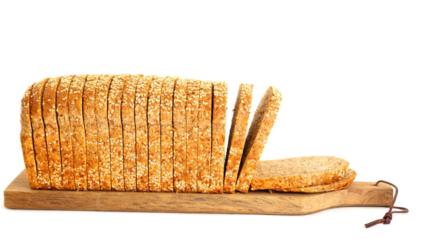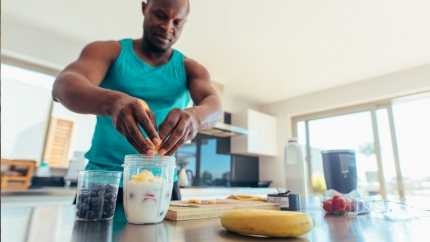
Neither salt nor sugar
The decrease of sugar used by the food industry resulted in a heated discussion all ove...

The decrease of sugar used by the food industry resulted in a heated discussion all ove...

Alternative protein ingredients came to claim their space. From sources already known, ...

Gramkow has recently launched protein solutions obtained by a dry and sustainable proce...

The decrease of sugar used by the food industry resulted in a heated discussion all over the world, giving more space to alternative markets. We are witnessing the growth of consumer’s power before the market. On July 2017, PepsiCo announced that, until 2025, at least two thirds of their beverages will have maximum 100 calories of added sugar. This decision came shortly after the World Health Organization (WHO) suggested the creation of a sugary drink tax over sweetened beverages as an effort to decrease obesity. Indeed, many countries have adopted this strategy. Portugal adopted this tax since 2018, following the example of other countries, such as France, Mexico, Hungary, Finland, Norway, UK and South Africa. With this inevitable change, we are witnessing the emergence of new product lines to follow the consumer’s demands. The market research and analysis agency Markets and Markets forecast that the sugar replacements market will hit U$ 16,53 billion until 2020, annual growth of 5,5%. Suppliers are looking at this switch and searching for alternatives. Due to the negative appeal of the common sweeteners, the search for new sources perceived as healthier is a trend. SWEET TASTE OF TOMORROW Coconut sugar is between the healthy alternatives to table sugar, especially due to the significant amount of minerals and vitamins. Nevertheless, fructose is present in coconut sugar, which is considered a “bad sugar” for being responsible to the metabolic syndrome of “insulin resistance”. For industrial applications, other sweeteners are on the hype, such as agave and rice syrup, characterized by their distinctive flavor and easy solubility in water. Agave syrup has low glycemic index, besides being sweeter that the common sugar. However, it is composed mainly by fructose, main reason why rice syrup is considered a better alternative. Despite of its lower sweetness compared to sucrose, rice syrup is fructose free and has high proportion of long chain sugar, which delays the increase of blood sugar levels. There are also natural sweeteners such as stevia and xylitol, increasingly sought by the industry. Both are non-cariogenic and ideal for diabetic use, whereby stevia doesn’t have caloric value and sweetness 300 times more than sucrose. Xylitol, different than stevia, has neutral flavor, therefore it can be used on several applications. Its sweetness is similar to sucrose, facilitating the replacement without the need of adapting the formulation. WHAT ABOUT BRAZIL? To tell the truth, the excessive use of any sweetener, being common or alternative, can be harmful. Euromonitor shows Brazil as the 9th biggest consumer of sugar in the world, with a consumption per capita of 126.3 gram per day, value five times higher than recommended. Companies and governamental institutions are already taking action to reduce this intake evidenced by the growth of alternative ingredients replacing sucrose and glucose. However, the replacements are still seen as niche products, to healthiness claims or to the reduction of sugars on nutritional labels. Ingredient suppliers are battling to avoid the biggest barrier faced by the industry: high prices. Even so, consumers are increasingly seeking value over price of the product.
Read more
Alternative protein ingredients came to claim their space. From sources already known, up to before unimaginable, we will share our vision of this changing market. Proteins are between the most demanded ingredients by consumers for years now, showing consistent growth. The high demand is related to higher awareness about health and longevity. For this reason, protein-enriched products are attracting the consumers interest. NEW PROTEIN SOURCES X VIABILITY Common sources, such as soy, milk and meat, are losing space to allergen-free, plant-based proteins. Among these, the most applied alternatives are rice and pea, which have shown more viability on industrial application and have been considered beneficial by the consumers. There is growing potential for developing products containing these plant-based proteins, especially in beverages. Other protein sources are emerging, conquering a growing market that wants to compete with animal proteins. Some of them will succeed, while many will not have industrial viability and restrict themselves to niche markets. Even if the production of plant-based proteins is increasing around the world, new sources like hemp, canola, mushroom and chickpea will have limited commercial reach and nutritional validation. AND THE OSCAR GOES TO… There are other rather curious sources, maybe even too eccentric for the Brazilian market. Insect proteins got a lot of attention in Europe and USA. Protein bars with cricket flour are already on the market. Belgium and Netherlands already have established markets for these products, mostly through online sales. But the Oscar for alternative protein eccentricity goes to… Honey bee larvae protein. According to a study published on the Journal of Apicultural Research, its nutritional value is comparable with meat protein. Being a delicacy with small-scale production, there is no preview of being sold as an ingredient, nor included in industrialized food products. The development of these proteins as food ingredients is challenging due to high prices, small volumes and limited demand. Regulatory approval also has to be considered, since there aren’t evidences of a short-term resolution. In the UK, insects can only be commercialized when sold as a whole, while in France there are opposing opinions of the local authorities. Challenges like food safety and cultural barriers have to be overcome. There is a long path ahead. WATCH OUT FOR… The market of alternative proteins cannot be underestimated. Many alternative approaches in food consumption are gradually becoming mainstream, and we have no doubt that the same movement will happen to proteins. With great emphasis on plant-based sources with bigger availability and proven nutritional benefits, the alternative protein market will surely grow in Brazil. However, uncommon alternatives are still far from being a reality to the Brazilian industry and culture.
Read more
Gramkow has recently launched protein solutions obtained by a dry and sustainable process, without the need of water or solvents. This unique process decreases the presence off-flavors and increases the functionality of the ingredients, bringing new opportunities for the Brazilian food industry. A diversity of innovative product ideas awaits to be explored through our new line of extruded proteins, allowing the development of clean label, highly nutritional, excellent tasting products. Starches, flours and protein act in synergy, promoting their functionality in order to deliver complete solutions. Together, they can improve dough consistency and are indicated to several projects with structural challenges, as in gluten-free products. Other possibilities include the development of protein-rich bread and pizza, without off-flavors. On semi-solid fillings, the performance of our clean label starches is similar to conventional version, with nutritional advantage, being allergen-free and obtained without chemical modification. Its high water absorption capacity is 700%, while its gelation properties in low temperatures provide good structure and homogeneity to the final product. To know more, reach out to our specialists.
Read more
The food industry is watching the increasing demand for convenient and healthy food, such as cereal and protein bars. Mintel states that more than one third of Brazilians regularly consume bars, half of them aging between 18 and 24 years. The number evidences that the bar and snack category is evolving into a new standard. Last year, sales of the segment increased 5%. The high demand for alternative products and with high quality ingredients will boost the valuation of the segment. Our team interviewed Bianca Yezzi, who has over 10 years of experience in bar and snack development and acts as consultant in the field. When she started, cereal bars dominated the market. According to her: “Since then, the industry has created different categories, with higher indulgence, specific functionalities and unusual flavors. Currently, the demand is focused on protein bars, followed by nut bars. Superfoods and energy bars, as well as vegan and organic bars, are gaining more and more attention, leaving cereal bars behind.” New consumption trends have changed the market outlook and boosted investment in quality and innovation. PROTEINS: THE SUPER TREND ALSO PRESENT IN BARS There is a lot of room for growth for protein bars, which originally were only consumed by athletes. The growing opportunity consists in exploring better textures and flavors to reach more consumers, emphasizing the use of non-artificial, plant-based, GMO-free, allergen-free and organic ingredients. Reinforcing the premiunizing trend that we pointed out in other articles, Bianca affirms: “the current market is very focused on premium protein bars.” THE HYPE FOR FUNCTIONALITY Bars are convenient and affordable alternatives for who seeks functional products. Internationally, it is already possible to find special bars for breastfeeding mothers, enriched with vitamins and essential minerals. The American brand Truth Bar developed a line of prebiotic and probiotic bars, which help to maintain the good operation of the gastrointestinal tract. Regarding allergen-free projects, according to Bianca, “there is a crazy demand, however, the industries face challenges in the production chain. Small suppliers get a head start due to their flexibility, although suffer higher losses because of a simpler process setup. In addition, it is important to have a solid quality control system to guarantee the absence of allergens.” In Brazil, a few options for unique markets have already been launched, such as Paleolithic and bulletproof bars. Bianca is emphatic about what has come to stay: “bars that offer new experiences in terms of smoothness, texture, flavor, distinctive ingredients.” She adds: “I notice that there is a continuously growing interest of the consumers to acquire innovative products, that really deliver what they promise. This is a key factor to a product’s success.” IN BRAZIL: POWERFUL MARKET THAT WILL DICTATE ITS GROWTH Convenience, flavor, functionality and focus on “on-the-go” consumption, bars can reunite these key factors in a single product. Industries active in this segment should be flexible in their production process, adapting quickly to new trends, new formulations, new designs and new packaging styles. The performance of the segment will certainly be guided by the healthy food trend, including a demand for more sophisticated, premium and indulgent options. We agree when Bianca states: “the segment reinvents itself with the availability of new ingredients, technologies and equipment. Machinery suppliers are adapting to meet smaller volumes, as well as distinctive shapes and sizes. The consumers benefit from these changes.” “The key word of this sector is growth.”, concludes Bianca with confidence of someone daily in touch with a very positive scenario. Considering that the Brazilian market size is equivalent to 5% of the American market, which holds nearly 40% of the global consumption of bars, the reader can opt to see the “half full or half empty glass”. Personally, I believe that we will watch an increase of product availability and a remarkable and fast expansion of the Brazilian bar market.
Read more
Many do not know: Brazil is between the countries with the biggest healthy food market, where the demand for products is bigger than the offer. Have a glimpe below on data, ideas and innovation trends. According to Euromonitor, the market of healthy products has grown 98% between 2009 and 2014 in Brazil, and reach a volume of sales of US$ 27,5 billion in 2015, leading the country to position of the fifth biggest healthy food and beverages market. Another research, conducted by Mintel, shows that 4 in 5 Brazilians are willing to pay more for healthy products, while 30% would like to see a wider range of healthy products available in supermarkets. Even in the midst of an economic crisis, there has been an increased awareness to pursue a healthy lifestyle. IT’S NOT A PASSING WAVE The big demand for healthy products didn’t pass unnoticed by multinational companies, which are adjusting themselves to consumers’ needs. AmBev acquired the juice brand “Do Bem”, first investment in the juice segment of the company, while Coke Brazil bought AdeS. In June of 2016, Coke and PepsiCo Brazil announced that they wouldn’t sale soda to school cafeterias anymore, creating opportunities for “mineral water, 100% fruit juice, coconut water and dairy beverages”, according to release. Due to the increasing demand for vegan products e lactose free, alternative beverages to animal milk are being highlighted as well. Lactose-free products are also popular in food segments other than beverages, experiencing 5,9% growth in 2015. According to Mintel, 17% of Brazilians believe that there is a lack of availability of plant-based products that could replace animal products, like plant-based proteins in sport nutrition products. In the gluten-free category, bakery is the sector that has the biggest growth – not because of the increase of celiac people, but due to gluten-restricting diets. The impact of the market was very visible in 2015, when gluten-free products had a 20% increase. As a consequence, the price is decreasing, and therefore, becoming more competitive. Bread, biscuits and cakes are in the spotlight of this segment. BEING HEALTHY EQUALS BEING HAPPY Researches performed in Warwick University, UK, and in Queensland University, Australia, shows that people following a healthy diet tend to be happier. Maybe because of that, Brazil finds itself between the 20 happiest countries in the world, according to the World Happiness Report (associated to WHO) published in 2016. In any case, Brazilian consumers will continue to surprise with their diet habits, leaving the industry to chase after the increasing demand.
Read more